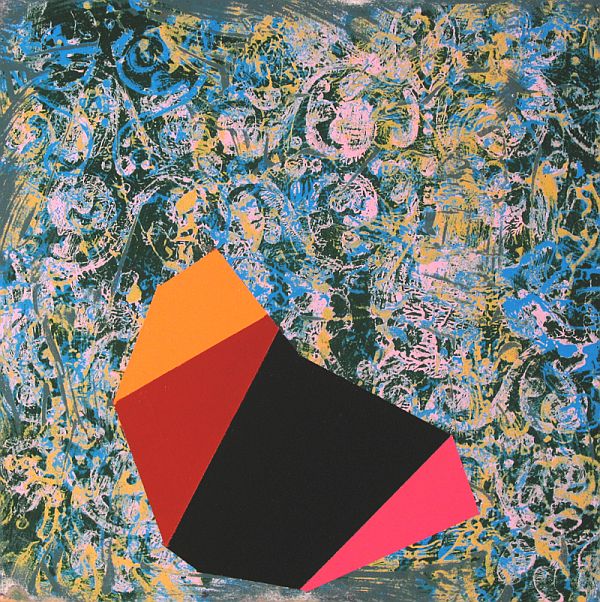Part 20 of an interview series in which I invite artists to respond to six questions about art, process, and creativity (previous interviews: 1, 2, 3, 4, 5, 6, 7, 8, 9, 10, 11, 12, 13, 14, 15, 16, 17, 18, 19). Today I talk to painter Tim McFarlane, from Philadelphia. Tim's paintings are an absorbing combination of symmetrical pattern overlaid with sensitive gestural mark-making, a procedure that is sometimes interestingly reversed, with a rough background giving way to a geometric shape. Looking at his paintings reminds me of the way that passages of music follow each other in a composition -- indicating that it's no accident that music and visual art use the same term.
web2012.jpg) |
| Imposition (indeterminate passage), 2012, acrylic on panel, 36 x 36 inches |
Philip Hartigan: What medium do you chiefly use, and why?
Tim McFarlane: I use acrylic paints in my work, primarily. I
began my art studies in high school using oils and really liked them. I still
like oils, actually. However, during a five-year hiatus from college, I began
experimenting with acrylic paints and discovered that they fit my somewhat
impatient personality being a fast drying medium. I can work my way through
ideas a lot faster with acrylic paints than oils and while acrylics might not
rival oils for their luminosity, I have found ways to make them work very well
for me.
Philip Hartigan: What piece are you currently working on?
Tim McFarlane: I am currently working on several small panels (six at12 x 12
inches each) that are a part of an ongoing series, and a couple of works on
paper. I usually work on several pieces at once, so it varies from day to day.
2012web.jpg) |
| Sequencer (folded), 2012, acrylic on panel, 24 x 24 inches |
Philip Hartigan: What creative surprises are happening in the current work?
Tim McFarlane: With a lot of my works on panels lately, I
have been building up layers of images with stencils using different colors in
each layer, covering everything with a solid layer of color and then sanding
the piece. I never know how the layers of color will interact once I’ve sanded
through them, so there’s always a nice surprise as the layers are
revealed-different combinations of patterns emerge that I don’t expect. It’s
interesting to watch the new patterns emerge during the sanding process. I
liken it to a kind of ‘reverse drawing’.
Philip Hartigan: What other artistic medium (or non-artistic
activity) feeds your creative process?
Tim McFarlane: Photography is another medium that I really
enjoy. The images that I take with a camera don’t relate directly to my
painting. I see photography as a separate way of being visually active. Music
and reading are other ways that I feed my creative process. I don’t make music,
but I listen to a wide range of music and am always looking for new things to
listen to. I have a special affinity for electronic-based music, like deep
house, techno, experimental electronic music, etc. There’s no telling what
you’ll hear from one moment to the next when my iPod is set to ‘random’: Tom
Waits, Nina Simone, Depeche Mode, the xx, Dead Kennedys, and on and on. Reading
fiction or poetry usually gets the visual creative fires going, also. I love
comics and read a lot of graphic novels, as well.
 |
| Cossia, 2012, acrylic on panel, 12 x 12 inches |
Philip Hartigan: What's the first ever piece of art you
remember making?
Tim McFarlane: The very first piece of art that I remember
making was a cardboard figure of a man made out of a shoebox that my mother
had. I was probably seven or so and that was the first thing that I put together by
myself, using only my imagination. I remember it being a very spontaneous act:
I pulled the box out from a bottom drawer in my mothers bureau, started cutting
it up with scissors and wound up with a rough, squared off approximation of a
figure. I don’t know what possessed me to do that, but it was the first time
that I remember consciously making something.
Philip Hartigan: Finally, and you can answer this in any way
that's meaningful to you: why are you an artist?
Tim McFarlane: I’m an artist because I have always been very
drawn towards visual expression. That, and art was the only thing that I really
wanted to work at when I chose to return to college after taking five years
off. As I stated earlier, I began seriously studying art in high school and was
counseled by my art teacher to study something else in college and do my art on
the side. I followed his advice, tried a couple of other majors and left school
for financial reasons. I continued making art in the meantime and thought that
if I ever got the chance to return to school, art is what I wanted to pursue.
That’s what I did and have been happily making work for almost thirty years. What I
really get out of being an artist is the excitement of dealing with mainly two
challenges; that of using abstraction to make visual sense out of my internal
experiences/reactions to the world and to make meaningful work that will
provoke thought.
If you liked this interview, and you'd like to keep up to date with the series, why not Subscribe, or sign-up via Google Connect, using one of the options over on the right? Thanks, and keep creating.